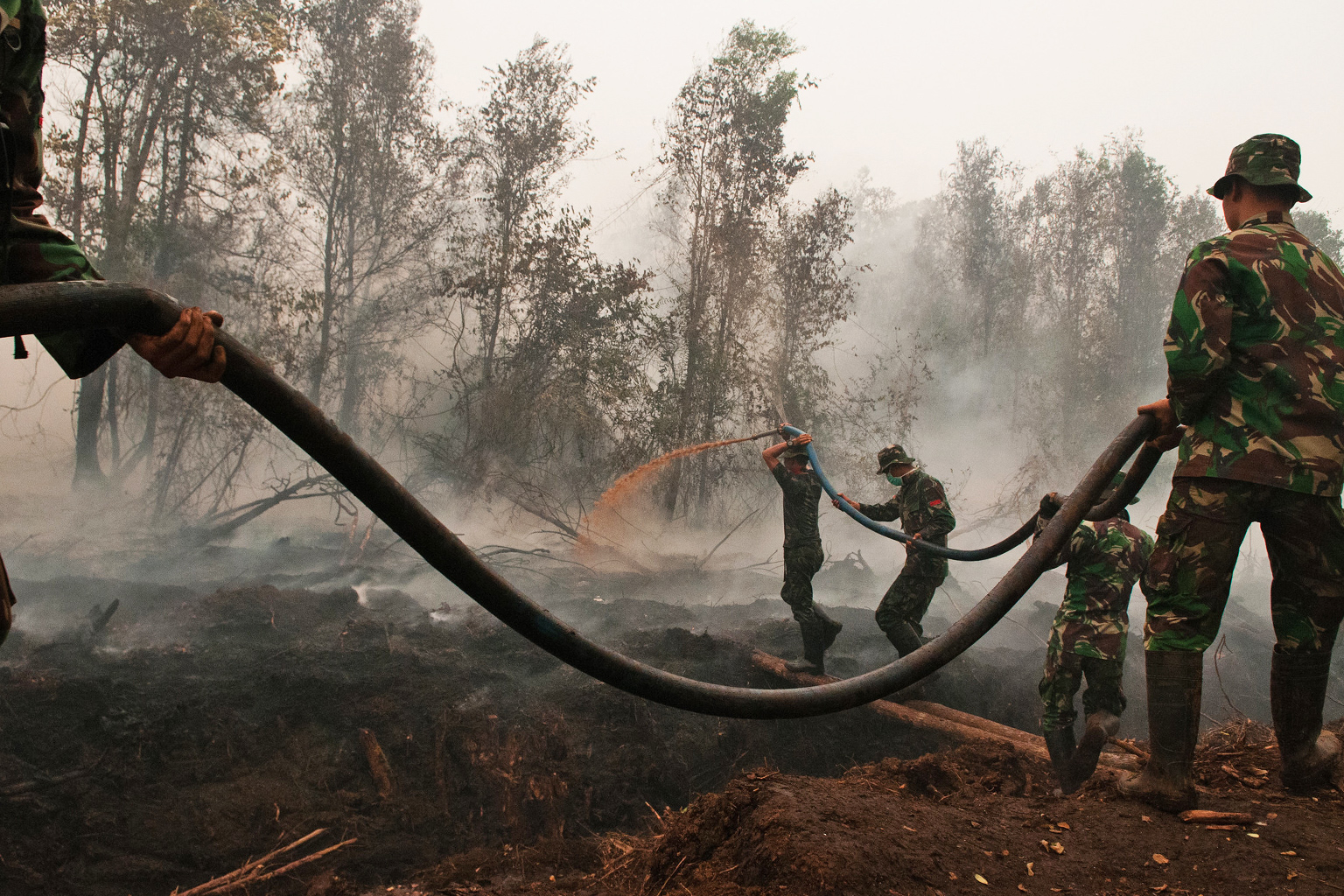- More than 11,000 community firefighters across Indonesia are readying for a likely El Niño year, better prepared than ever before.
- One community outfit of five volunteers in Sumatra’s province is monitoring the local peatland with the help of a drone procured from the village budget.
- Officials hope that a legal crackdown on farmers burning combined with improved community capacity can limit wildfires this year.
When battling to protect Indonesia’s peatlands during wildfire crises in 2015 and 2019, most volunteer firefighters confronted the infernos with a dire shortage of equipment and technological resources. For community firefighters like Indra My Lubis, that disadvantage is beginning to shift.
Around three years ago, the village of Bathin Sobanga, south of the city of Dumai in Sumatra’s Riau province, used the village budget to procure a drone to help monitor their coverage area, according to Indra.
“It’s been a huge help,” said Indra, who leads Bathin Sobanga’s Masyarakat Peduli Api (MPA), village volunteer firefighters. “We can easily monitor whether there is any smoke.”
Indonesia established a volunteer firefighting network more than a decade ago as the first line of defense against wildfires. Groups of local volunteers were given basic fire training, in the hope that quick interventions by those who knew the ground best would extinguish a blaze before it grew out of control. Manggala Agni, the government fire department run by the Indonesian Ministry of Environment and Forestry, would then be better able to triage resources to battle the worst fires.

However, insufficient investment and a lack of coordination in the early years undermined building capacity in the MPA network, according to several field workers.
“One way of increasing community participation is through the MPA program and there has been a lot of progress, including financial support from the government and the private sector,” Riko Kurniawan, who runs the Riau provincial office of the Indonesian Forum for the Environment (Walhi), a prominent civil society group, told Mongabay.
In 2015, a strong El Niño delayed beyond October the arrival of sustained rains needed to douse wildfires. The result was immolation of around 4.6 million hectares (11.4 million acres) of land in Sumatra and Kalimantan, the Indonesian part of Borneo. One study by Harvard and Columbia universities suggested air pollution generated by the catastrophe may have caused 100,000 early deaths.
The most recent update by the World Meteorological Organization indicates a 70-80% likelihood of El Niño conditions emerging between July and October this year.
Community liaison officers with Indonesia’s police have been working in the field for weeks, checking blocks in canals built to drain peatlands for plantations, and communicating fire risks to local farmers.
Several high-level officials in Indonesia have made public statements emphasizing that coordination between regional governments, military, police and firefighters has been underway for months.
“Since April we have been coordinating frequently with Polda as well as Kodam, Korem, Polres [military and police commands] all the way down to the villages and companies’ firefighting units,” said Sutarmidji, the governor of Central Kalimantan province, which accounts for around 2.8 million hectares (6.9 million acres) of peatlands, an area more than 35 times larger than New York City.

It takes a village
In a broadcast interview with CNN Indonesia in late June, Laksmi Dhewanthi, the Indonesian environment ministry’s director for climate change, said the role of the community firefighters had been “proven” since President Joko Widodo issued sweeping new policy instructions in 2020 in the hope of finding a “permanent solution” to wildfires.
The number of community firefighters across Indonesia has increased to more than 11,000, and the function of these units is evolving beyond first response to proactive prevention in the community. The community units are increasingly being tasked with ensuring farmers do not burn biomass for any reason, such as to open new land or bring nitrogen back into the soil after harvest.
“The role of the Masyarakat Peduli Api is not only to be prepared to extinguish fires but actually to provide solutions to the community to fulfil their social and economic needs which then benefits the environment,” the ministry’s Laksmi said in the CNN interview.
MPA leader Indra told Mongabay the workload around Bathin Sobanga village had been light in the year to late June compared with previous years, but meteorologists warn this period is still the calm before a possible firestorm.
“People’s knowledge about the dangers of forest fires — it’s already much more aware,” Indra said.
His team of five local volunteers are also better resourced with new firefighting equipment, plus the eye in the sky procured from the village budget.
“I’m not worried,” Indra said. “The MPA stays on standby.”
Banner image: A firefighter puts out fires in a peatland in Indonesia. Image by DenY Krisbiyantoro via Wikimedia Commons (CC BY-SA 4.0).
Australia bushfires may have caused global climate phenomenon La Niña: Study
Citation:
Koplitz, S. N., Mickley, L. J., Marlier, M. E., Buonocore, J. J., Kim, P. S., Liu, T., … Myers, S. S. (2016). Public health impacts of the severe haze in equatorial Asia in September–October 2015: Demonstration of a new framework for informing fire management strategies to reduce downwind smoke exposure. Environmental Research Letters, 11(9), 094023. doi:10.1088/1748-9326/11/9/094023













